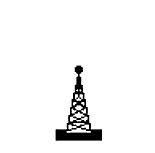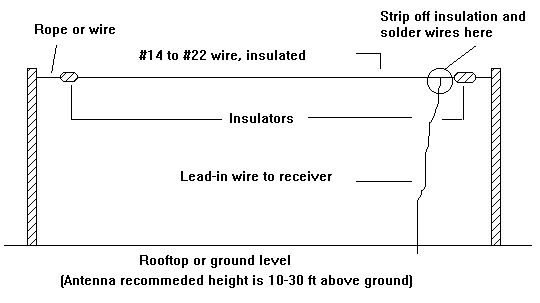VINTAGE RADIO ANTENNA TIPS



A GUIDE TO YOUR "SKYHOOK"
Many people want to know a bit more about what is considered an appropriate
outdoor and/or indoor antenna for their set than the brief notes in the other info
sheet, "Healthy Radio Tips", so this little offering might clear things up a bit.
First, the outdoor antenna. This type is almost always the "Inverted L" category,
the longest part of the antenna being horizontal, and the short part leading down
to the receiver, like this:

A high antenna brings in lots of signal. As the antenna height decreases, the
signal strength decreases. A good antenna will help to override man-made
static and the internal noise generated by the set itself. Everything from electric
shavers to electric blankets, microwave ovens, etc, can generate annoying
static. In most cases a good antenna will bring in enough signal to reduce these
annoyances.
Indoor antennas: an indoor antenna consists of 20 to 100 feet of insulated
wire attached to the antenna terminal of the receiver and strung either in a
straight line in the interior of a building or carried on various supports in various
directions through the rooms of a building or house.
An indoor antenna may be placed in a long room such as an attic with the
use of the same insulators and supports employed in outdoor antenna
construction. At the other extreme of construction we find a piece of wire laid
along the baseboard of the ceiling or the floor and extending through several
rooms. Either type will work, but the more careful the construction the better will
be the results.
An indoor antenna will not deliver as strong impulses to the receiver as an
outdoor one of the same size. But if the receiver has sufficient amplification the
results may be surprisingly good. A receiver with one stage of RF and two of AF
operated with an indoor antenna will deliver good speaker volume from stations
200 miles away at night under favorable conditions. With two stages of RF and
two stages of AF amplification, this range can be extended to 500 miles.
Generally speaking, most radio stations today operate under such high
power that for general use in hearing local AM radio stations, an outdoor
antenna is not necessary except on the most primitive sets. If, however, your set
has a good shortwave section on it, or you wish to hear AM stations a great
distance away, an outside antenna might be worth the extra trouble. For weak
signal reception, an outside antenna, mounted high and in the clear is hard to
beat.
The best length of antenna (indoor or outdoor) depends on local
conditions and on the type of receiver being used. The following list gives
lengths that are generally satisfactory. The lengths are the sum of the horizontal
portion of the antenna, the lead-in to the receiver, and the ground connection
from the receiver:
| Receivers having six or more tubes: | 40 to 50 ft. |
| 5 tube, TRF sets: | 60 to 75 ft. |
| For 4 tube sets with one RF stage: | 80 to 100 ft. |
| For 3 tube regenerative sets: | 100 to 120 ft |
| For 1 tube sets, crystal sets, etc: | 100 to 200 ft. |
It might also be said that at this point that in some cases you can actually
degrade reception by using an antenna that is too long, and therefore delivers
too much signal to the set! Intermodulation distortion, front-end overload and
images may start to rear their ugly head if you try to cram too much signal down
your radio's throat. Experimentation is the key. Come on, you really didn't have
anything very important to do this Saturday, did you?
An outside antenna can be made from any bare or insulated copper wire from #14 to #20 gauge. It doesn't have to be insulated, but if it is, it does hold up against the elements better.
Happy Listening!

© 1996-2017 by Lin Robertson at
Moonlight Systems
All Rights Reserved
(Click here for Copyright info)
Thoughts? Comments? Brickbats?
Send me some e-mail!
|









